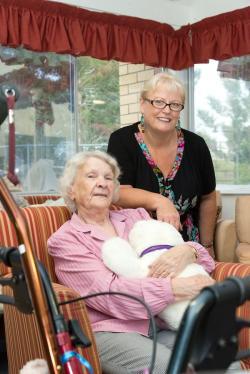First things first: No one is suggesting we lock all the old people in a room full of robots and throw away the key—though when Grandpa gets on one of his racist rants, that might sound tempting. But thanks to some new research, it does seem as though robots have something to offer the elderly, especially those suffering from dementia.
In a pilot study published by the Journal of Gerontological Nursing, a team of Australian and German researchers allowed elderly patients stricken with dementia to interact with “therapeutic companion robots.” In this case, the researchers used a Japanese creation called Paro—robots designed to sense touch, light, sound, temperature, and posture. The robots can show emotions, including happiness, surprise, and anger. They can also adapt to a user’s preferences, repeating actions that result in petting and avoiding actions they associate with being hit.
Oh, and did I mention the companion robots look like adorable harp seal pups? They even mimic authentic seal calls. (Wendy Moyle, one of the paper’s authors, told me this species was chosen because most people don’t have pre-existing experiences with baby seals they way they might with dogs or cats. Thus, patients are less likely to have a negative reaction to the robot.)
Using clinical dementia measurements, the researchers determined the impact the robots had on the test group’s behavior. They measured “tendency to wander, level of apathy, levels of depression, and anxiety ratings.” (Another group was given the same evaluation after a reading group to make sure the results weren’t just indicative of any old stimulation.) In the end, they found the robots to produce “a positive, clinically meaningful influence on quality of life, increased levels of pleasure and also reduced displays of anxiety.”
These results are perhaps not so surprising, as other robots have shown promise working with children on the autism spectrum and studies have shown pets and plants to be beneficial for the psychological wellbeing of the elderly. However, living animals present health risks for assisted care facilities and extra duties for the workers who run them.
“I think this offers the very interesting alternative of a pet surrogate,” says Sharon Brangman, chief of geriatrics at Upstate Medical University and former president of the American Geriatrics Society.* “I always have concerns about substituting inanimate objects for the real thing, but in this case, since it’s something that isn’t really assessing or evaluating the individual and really just providing some measure of comfort, I think it could be a suitable alternative.”
The paper’s authors also suggest that this technology would be easily implemented in the home, perhaps allowing families to better care for their aging relatives when assisted living isn’t a viable option—without making a robot the sole caretaker like in the recent movie Robot & Frank.
Robotic companion seals aren’t exactly Rosie from The Jetsons, but this is at least one very real way robots could play a more significant role in the homes of tomorrow.
Correction, June 27, 2013: This blog post originally left the “s” off of Geriatrics in the American Geriatrics Society.
